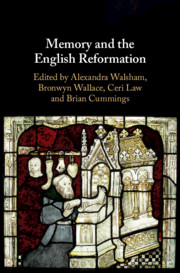Book contents
- Memory and the English Reformation
- Memory and the English Reformation
- Copyright page
- Dedication
- Contents
- Figures
- Contributors
- Preface and Acknowledgements
- Abbreviations
- Introduction
- Part I Events and Temporalities
- Part II Objects and Places
- 7 Dolls and Idols in the English Reformation
- 8 Monuments and the Reformation
- 9 Memorable Motifs
- 10 Revitalising Antiquities
- 11 Rereading Ruins
- 12 ‘Monuments of Our Indignation’
- Part III Lives and Afterlives
- Part IV Rituals and Bodies
- Index
7 - Dolls and Idols in the English Reformation
from Part II - Objects and Places
Published online by Cambridge University Press: 30 October 2020
- Memory and the English Reformation
- Memory and the English Reformation
- Copyright page
- Dedication
- Contents
- Figures
- Contributors
- Preface and Acknowledgements
- Abbreviations
- Introduction
- Part I Events and Temporalities
- Part II Objects and Places
- 7 Dolls and Idols in the English Reformation
- 8 Monuments and the Reformation
- 9 Memorable Motifs
- 10 Revitalising Antiquities
- 11 Rereading Ruins
- 12 ‘Monuments of Our Indignation’
- Part III Lives and Afterlives
- Part IV Rituals and Bodies
- Index
Summary
This chapter begins with a sermon from the 1530s that describes the iconoclastic practice of giving formerly sacred objects to children, in order to desacralise them. It shows that this was a widespread activity during the Reformation, and relates this practice of iconoclastic child’s play to the common polemical tactic of comparing traditional Roman Catholic religion to the inane playing of children. It then argues, however, that the actual transformation of such objects into playthings is more complex than this polemical elision, and shows that, when related to broader Christian traditions, the implicit claim that playing with an object is necessarily to demean it becomes far less clear. Play could be a way of accessing or reflecting the divine, not trivialising it. The object of iconoclastic child’s play, suspended between idol and doll, does not therefore clearly lack value, but becomes a potent and unstable object upon which competing conceptions and valuations converge, and within which they can co-exist.
- Type
- Chapter
- Information
- Memory and the English Reformation , pp. 153 - 167Publisher: Cambridge University PressPrint publication year: 2020
- 1
- Cited by

